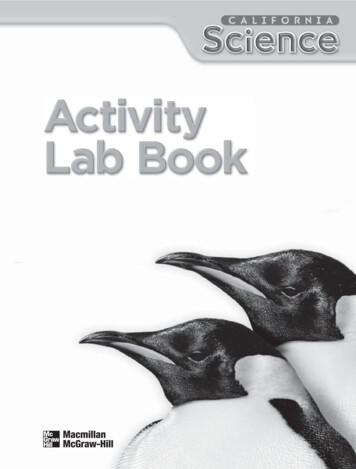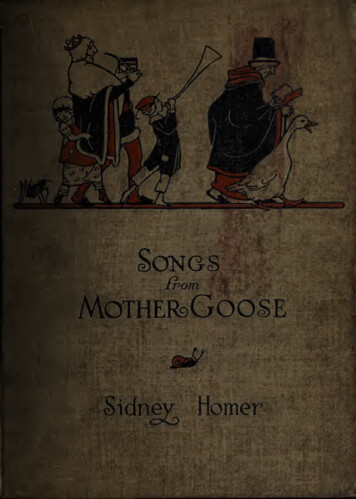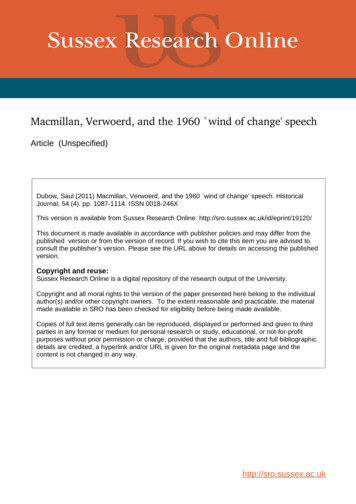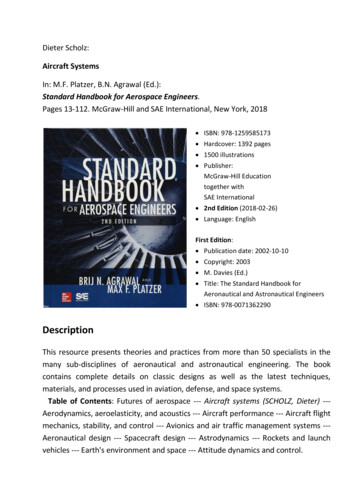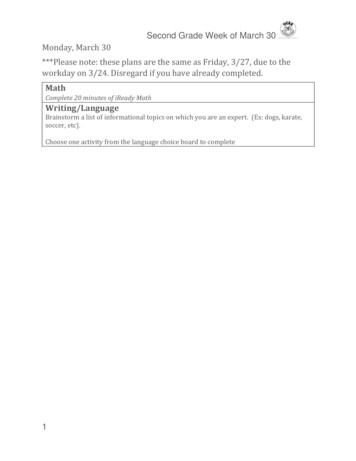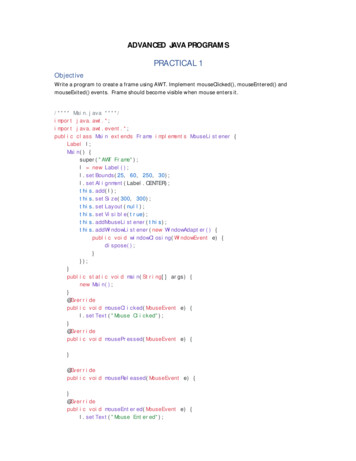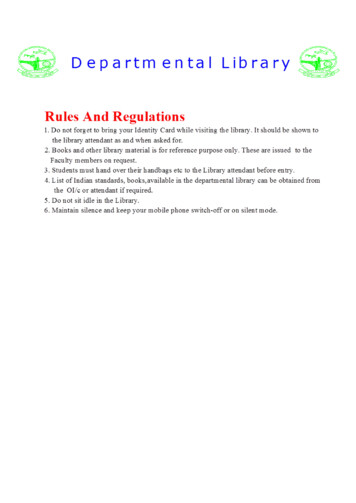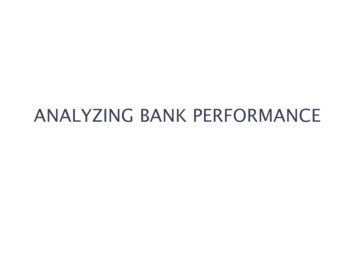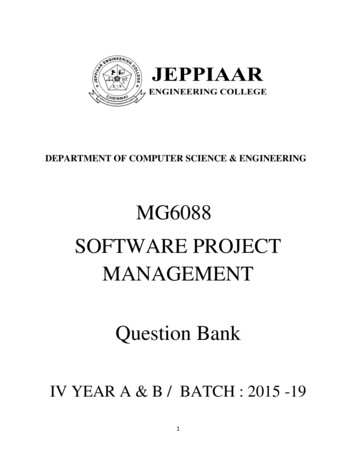
Transcription
GRADE 5CONTENTSHow to Use theAssessment Guide . . . . . . . . . . . .1Teacher Interview . . . . . . . . . . . . . . .3Journal Writing . . . . . . . . . . . . . . . . .5Journal Writing:Problem Solving . . . . . . . . . . . . . .7Paper-and-Pencil Tests . . . . . . . . . . .8Performance Assessment . . . . . . . .10Portfolio Assessment . . . . . . . . . . .11Self-Assessment . . . . . . . . . . . . . . .13Teacher InterviewQuestionnaire . . . . . . . . . . . . . . .15Student Answer Sheet . . . . . . . . . .16Monitoring Student Progress . . . .17Monitoring Class Progress . . . . . . .19My Portfolio . . . . . . . . . . . . . . . . . . .20Portfolio Assessment Form . . . . . .21Self-Assessment Checklist . . . . . . .22Chapter 2Teacher Interview . . . . . . . . . . . . . .41Journal Writing . . . . . . . . . . . . . . . .42Monitoring Student Progress:Scoring Chart . . . . . . . . . . . . . . .43Prescription Table . . . . . . . . . . . .44Chapter 2 Test (Form A) . . . . . . . . . .45Chapter 2 Test (Form B) . . . . . . . . . .47Inventory TestMonitoring Student Progress:Scoring Chart . . . . . . . . . . . . . . .23Inventory Test (Form A) . . . . . . . . . .25Inventory Test (Form B) . . . . . . . . . . .29Chapter 3Teacher Interview . . . . . . . . . . . . . .61Journal Writing . . . . . . . . . . . . . . . .62Monitoring Student Progress:Scoring Chart . . . . . . . . . . . . . . .63Prescription Table . . . . . . . . . . . .64Chapter 3 Test (Form A) . . . . . . . . . .65Chapter 3 Test (Form B) . . . . . . . . . .67iiGrade 5Chapter 4Teacher Interview . . . . . . . . . . . . . .69Journal Writing . . . . . . . . . . . . . . . .70 Macmillan/McGraw-HillChapter 1Teacher Interview . . . . . . . . . . . .33Journal Writing . . . . . . . . . . . . . . . .34Monitoring Student Progress:Scoring Chart . . . . . . . . . . . . . . .35Prescription Table . . . . . . . . . . . .36Chapter 1 Test (Form A) . . . . . . . . . .37Chapter 1 Test (Form B) . . . . . . . . . .39Unit 1Performance AssessmentTeacher Notes . . . . . . . . . . . . . . .49Scoring Rubric . . . . . . . . . . . . . . .50Student Activity . . . . . . . . . . . . .51Unit 1 Monitoring Student Progress:Scoring Chart . . . . . . . . . . . . . . .52Unit 1 Test (Form A) . . . . . . . . . . .53Unit 1 Test (Form B) . . . . . . . . . . .57
Chapter 4, continuedMonitoring Student Progress:Scoring Chart . . . . . . . . . . . . . . .71Prescription Table . . . . . . . . . . . .72Chapter 4 Test (Form A) . . . . . . . . . .73Chapter 4 Test (Form B) . . . . . . . . . .75Unit 2Performance AssessmentTeacher Notes . . . . . . . . . . . . . . .77Scoring Rubric . . . . . . . . . . . . . . .78Student Activity . . . . . . . . . . . . .79Unit 2 Monitoring Student Progress:Scoring Chart . . . . . . . . . . . . . . .80Unit 2 Test (Form A) . . . . . . . . . . .81Unit 2 Test (Form B) . . . . . . . . . . .85 Macmillan/McGraw-HillChapter 5Teacher Interview . . . . . . . . . . . . . .89Journal Writing . . . . . . . . . . . . . . . .90Monitoring Student Progress:Scoring Chart . . . . . . . . . . . . . . .91Prescription Table . . . . . . . . . . . .92Chapter 5 Test (Form A) . . . . . . . . . .93Chapter 5 Test (Form B) . . . . . . . . . .95Chapter 6Teacher Interview . . . . . . . . . . . . . .97Journal Writing . . . . . . . . . . . . . . . .98Monitoring Student Progress:Scoring Chart . . . . . . . . . . . . . . .99Prescription Table . . . . . . . . . . .100Chapter 6 Test (Form A) . . . . . . . .101Chapter 6 Test (Form B) . . . . . . . . .103Unit 3Performance AssessmentTeacher Notes . . . . . . . . . . . . . .105Scoring Rubric . . . . . . . . . . . . . .106Student Activity . . . . . . . . . . . .107Unit 3 Monitoring Student Progress:Scoring Chart . . . . . . . . . . . . . .108Unit 3 Test (Form A) . . . . . . . . . .109Unit 3 Test (Form B) . . . . . . . . . .113Chapter 7Teacher Interview . . . . . . . . . . . . .117Journal Writing . . . . . . . . . . . . . . .118Monitoring Student Progress:Scoring Chart . . . . . . . . . . . . . .119Prescription Table . . . . . . . . . . .120Chapter 7 Test (Form A) . . . . . . . .121Chapter 7 Test (Form B) . . . . . . . . .123Chapter 8Teacher Interview . . . . . . . . . . . . .125Journal Writing . . . . . . . . . . . . . . .126Monitoring Student Progress:Scoring Chart . . . . . . . . . . . . . .127Prescription Table . . . . . . . . . . .128Chapter 8 Test (Form A) . . . . . . . .129Chapter 8 Test (Form B) . . . . . . . . .131Unit 4Performance AssessmentTeacher Notes . . . . . . . . . . . . . .133Scoring Rubric . . . . . . . . . . . . . .134Student Activity . . . . . . . . . . . .135Grade 5iii
Unit 4 Monitoring Student Progress:Scoring Chart . . . . . . . . . . . . . .136Unit 4 Test (Form A) . . . . . . . . . .137Unit 4 Test (Form B) . . . . . . . . . .141Chapter 9Teacher Interview . . . . . . . . . . . . .145Journal Writing . . . . . . . . . . . . . . .146Monitoring Student Progress:Scoring Chart . . . . . . . . . . . . . .147Prescription Table . . . . . . . . . . .148Chapter 9 Test (Form A) . . . . . . . .149Chapter 9 Test (Form B) . . . . . . . . .151Chapter 10Teacher Interview . . . . . . . . . . . . .153Journal Writing . . . . . . . . . . . . . . .154Monitoring Student Progress:Scoring Chart . . . . . . . . . . . . . .155Prescription Table . . . . . . . . . . .156Chapter 10 Test (Form A) . . . . . . .157Chapter 10 Test (Form B) . . . . . . . .159Unit 5Performance AssessmentTeacher Notes . . . . . . . . . . . . . .161Scoring Rubric . . . . . . . . . . . . . .162Student Activity . . . . . . . . . . . .163Unit 5 Monitoring Student Progress:Scoring Chart . . . . . . . . . . . . . .164Unit 5 Test (Form A) . . . . . . . . . .165Unit 5 Test (Form B) . . . . . . . . . .169ivGrade 5Chapter 11Teacher Interview . . . . . . . . . . . . .173Journal Writing . . . . . . . . . . . . . . .174Monitoring Student Progress:Scoring Chart . . . . . . . . . . . . . .175Prescription Table . . . . . . . . . . .176Chapter 11 Test (Form A) . . . . . . .177Chapter 11 Test (Form B) . . . . . . . .179Chapter 12Teacher Interview . . . . . . . . . . . . .181Journal Writing . . . . . . . . . . . . . . .182Monitoring Student Progress:Scoring Chart . . . . . . . . . . . . . .183Prescription Table . . . . . . . . . . .184Chapter 12 Test (Form A) . . . . . . .185Chapter 12 Test (Form B) . . . . . . . .187Unit 6Performance AssessmentTeacher Notes . . . . . . . . . . . . . .189Scoring Rubric . . . . . . . . . . . . . .190Student Activity . . . . . . . . . . . .191Unit 6 Monitoring Student Progress:Scoring Chart . . . . . . . . . . . . . .192Unit 6 Test (Form A) . . . . . . . . . .193Unit 6 Test (Form B) . . . . . . . . . .197Chapter 13Teacher Interview . . . . . . . . . . . . .201Journal Writing . . . . . . . . . . . . . . .202Monitoring Student Progress:Scoring Chart . . . . . . . . . . . . . .203Prescription Table . . . . . . . . . . .204 Macmillan/McGraw-HillUnit 4, continued
Chapter 13, continuedChapter 13 Test (Form A) . . . . . . .205Chapter 13 Test (Form B) . . . . . . . .207Chapter 14Teacher Interview . . . . . . . . . . . . .209Journal Writing . . . . . . . . . . . . . . .210Monitoring Student Progress:Scoring Chart . . . . . . . . . . . . . .211Prescription Table . . . . . . . . . . .212Chapter 14 Test (Form A) . . . . . . .213Chapter 14 Test (Form B) . . . . . . . .215 Macmillan/McGraw-HillUnit 7Performance AssessmentTeacher Notes . . . . . . . . . . . . . .217Scoring Rubric . . . . . . . . . . . . . .218Student Activity . . . . . . . . . . . .219Unit 7 Monitoring Student Progress:Scoring Chart . . . . . . . . . . . . . .220Unit 7 Test (Form A) . . . . . . . . . .221Unit 7 Test (Form B) . . . . . . . . . .225Chapter 15Teacher Interview . . . . . . . . . . . . .229Journal Writing . . . . . . . . . . . . . . .230Monitoring Student Progress:Scoring Chart . . . . . . . . . . . . . .231Prescription Table . . . . . . . . . . .232Chapter 15 Test (Form A) . . . . . . .233Chapter 15 Test (Form B) . . . . . . . .235Chapter 16Teacher Interview . . . . . . . . . . . . .237Journal Writing . . . . . . . . . . . . . . .238Monitoring Student Progress:Scoring Chart . . . . . . . . . . . . . .239Prescription Table . . . . . . . . . . .240Chapter 16 Test (Form A) . . . . . . .241Chapter 16 Test (Form B) . . . . . . . .243Unit 8Performance AssessmentTeacher Notes . . . . . . . . . . . . . .245Scoring Rubric . . . . . . . . . . . . . .246Student Activity . . . . . . . . . . . .247Unit 8 Monitoring Student Progress:Scoring Chart . . . . . . . . . . . . . .248Unit 8 Test (Form A) . . . . . . . . . .249Unit 8 Test (Form B) . . . . . . . . . .253Chapter 17Teacher Interview . . . . . . . . . . . . .257Journal Writing . . . . . . . . . . . . . . .258Monitoring Student Progress:Scoring Chart . . . . . . . . . . . . . .259Prescription Table . . . . . . . . . . .260Chapter 17 Test (Form A) . . . . . . .261Chapter 17 Test (Form B) . . . . . . . .263Chapter 18Teacher Interview . . . . . . . . . . . . .265Journal Writing . . . . . . . . . . . . . . .266Monitoring Student Progress:Scoring Chart . . . . . . . . . . . . . .267Prescription Table . . . . . . . . . . .268Chapter 18 Test (Form A) . . . . . . .269Chapter 18 Test (Form B) . . . . . . . .271Grade 5v
Chapter 19Teacher Interview . . . . . . . . . . . . .285Journal Writing . . . . . . . . . . . . . . .286Monitoring Student Progress:Scoring Chart . . . . . . . . . . . . . .287Prescription Table . . . . . . . . . . .288Chapter 19 Test (Form A) . . . . . . .289Chapter 19 Test (Form B) . . . . . . . .291Chapter 20Teacher Interview . . . . . . . . . . . . .293Journal Writing . . . . . . . . . . . . . . .294Monitoring Student Progress:Scoring Chart . . . . . . . . . . . . . .295Prescription Table . . . . . . . . . . .296Chapter 20 Test (Form A) . . . . . . .297Chapter 20 Test (Form B) . . . . . . . .299Unit 10Performance AssessmentTeacher Notes . . . . . . . . . . . . . .301Scoring Rubric . . . . . . . . . . . . . .302Student Activity . . . . . . . . . . . .303viGrade 5Unit 10 Monitoring Student Progress:Scoring Chart . . . . . . . . . . . . . .304Unit 10 Test (Form A) . . . . . . . . .305Unit 10 Test (Form B) . . . . . . . . .309Chapter 21Teacher Interview . . . . . . . . . . . . .313Journal Writing . . . . . . . . . . . . . . .314Monitoring Student Progress:Scoring Chart . . . . . . . . . . . . . .315Prescription Table . . . . . . . . . . .316Chapter 21 Test (Form A) . . . . . . .317Chapter 21 Test (Form B) . . . . . . . .319Chapter 22Teacher Interview . . . . . . . . . . . . .321Journal Writing . . . . . . . . . . . . . . .322Monitoring Student Progress:Scoring Chart . . . . . . . . . . . . . .323Prescription Table . . . . . . . . . . .324Chapter 22 Test (Form A) . . . . . . .325Chapter 22 Test (Form B) . . . . . . . .327Unit 11Performance AssessmentTeacher Notes . . . . . . . . . . . . . .329Scoring Rubric . . . . . . . . . . . . . .330Student Activity . . . . . . . . . . . .331Unit 11 Monitoring Student Progress:Scoring Chart . . . . . . . . . . . . . .332Unit 11 Test (Form A) . . . . . . . . .333Unit 11 Test (Form B) . . . . . . . . .337 Macmillan/McGraw-HillUnit 9Performance AssessmentTeacher Notes . . . . . . . . . . . . . .273Scoring Rubric . . . . . . . . . . . . . .274Student Activity . . . . . . . . . . . .275Unit 9 Monitoring Student Progress:Scoring Chart . . . . . . . . . . . . . .276Unit 9 Test (Form A) . . . . . . . . . .277Unit 9 Test (Form B) . . . . . . . . . .281
Macmillan/McGraw-HillChapter 23Teacher Interview . . . . . . . . . . . . .341Journal Writing . . . . . . . . . . . . . . .342Monitoring Student Progress:Scoring Chart . . . . . . . . . . . . . .343Prescription Table . . . . . . . . . . .344Chapter 23 Test (Form A) . . . . . . .345Chapter 23 Test (Form B) . . . . . . . .347Chapter 26Teacher Interview . . . . . . . . . . . . .377Journal Writing . . . . . . . . . . . . . . .378Monitoring Student Progress:Scoring Chart . . . . . . . . . . . . . .379Prescription Table . . . . . . . . . . .380Chapter 26 Test (Form A) . . . . . . .381Chapter 26 Test (Form B) . . . . . . . .383Chapter 24Teacher Interview . . . . . . . . . . . . .349Journal Writing . . . . . . . . . . . . . . .350Monitoring Student Progress:Scoring Chart . . . . . . . . . . . . . .351Prescription Table . . . . . . . . . . .352Chapter 24 Test (Form A) . . . . . . .353Chapter 24 Test (Form B) . . . . . . . .355Unit 13Performance AssessmentTeacher Notes . . . . . . . . . . . . . .385Scoring Rubric . . . . . . . . . . . . . .386Student Activity . . . . . . . . . . . .387Unit 13 Monitoring Student Progress:Scoring Chart . . . . . . . . . . . . . .388Unit 13 Test (Form A) . . . . . . . . .389Unit 13 Test (Form B) . . . . . . . . .393Unit 12Performance AssessmentTeacher Notes . . . . . . . . . . . . . .357Scoring Rubric . . . . . . . . . . . . . .358Student Activity . . . . . . . . . . . .359Unit 12 Monitoring Student Progress:Scoring Chart . . . . . . . . . . . . . .360Unit 12 Test (Form A) . . . . . . . . .361Unit 12 Test (Form B) . . . . . . . . .365Chapter 27Teacher Interview . . . . . . . . . . . . .397Journal Writing . . . . . . . . . . . . . . .398Monitoring Student Progress:Scoring Chart . . . . . . . . . . . . . .399Prescription Table . . . . . . . . . . .400Chapter 27 Test (Form A) . . . . . . .401Chapter 27 Test (Form B) . . . . . . . .403Chapter 25Teacher Interview . . . . . . . . . . . . .369Journal Writing . . . . . . . . . . . . . . .370Monitoring Student Progress:Scoring Chart . . . . . . . . . . . . . .371Prescription Table . . . . . . . . . . .372Chapter 25 Test (Form A) . . . . . . .373Chapter 25 Test (Form B) . . . . . . . .375Chapter 28Teacher Interview . . . . . . . . . . . . .405Journal Writing . . . . . . . . . . . . . . .406Monitoring Student Progress:Scoring Chart . . . . . . . . . . . . . .407Prescription Table . . . . . . . . . . .408Chapter 28 Test (Form A) . . . . . . .409Chapter 28 Test (Form B) . . . . . . . .411Grade 5vii
Final TestMonitoring Student Progress:Scoring Chart . . . . . . . . . . . . . .425Final Test (Form A) . . . . . . . . . . . . .427Final Test (Form B) . . . . . . . . . . . . . .431Annotated Test Pages . . . . . . . . .435 Macmillan/McGraw-HillUnit 14Performance AssessmentTeacher Notes . . . . . . . . . . . . . .413Scoring Rubric . . . . . . . . . . . . . .414Student Activity . . . . . . . . . . . .415Unit 14 Monitoring Student Progress:Scoring Chart . . . . . . . . . . . . . .416Unit 14 Test (Form A) . . . . . . . . .417Unit 14 Test (Form B) . . . . . . . . .421viii Grade 5
How to Use the Assessment GuideMacmillan/McGraw-Hill Math includes opportunities to assess students’knowledge on both a formal and an informal basis. This Assessment Guide isintended to assist you in developing, organizing, and managing multipleassessment strategies.It is the philosophy of this series that the primary purpose of assessment is toimprove students’ learning, not just to grade their work. Assessment should providean occasion for students to learn and to evaluate their own work. It should be anintegral part of instruction, not simply an end point. Therefore, strategies formonitoring progress as well as summative measures, such as chapter tests, are allincluded in this guide.The following is a brief description of the seven assessment strategiesprovided in this program.Teacher InterviewThe Teacher Interview is an informal assessment strategy designed to help youmeasure your students’ understanding of math concepts. This guide includes aTeacher Interview Questionnaire (see page 15) that you can use to document yourinterviews with students. It also provides information on questioning strategies andhelp with interviewing techniques.Journal WritingJournal Writing is another informal assessment strategy. Here students are given theopportunity to write down how they think about math concepts in their journals.The program provides numerous opportunities for journal writing. Macmillan/McGraw-HillJournal Writing: Problem SolvingThe problem-solving section of journal writing contains specifically designedproblems based on the material covered in each chapter. These problemsgive students the opportunity to express their math thinking andproblem-solving skills in a written setting. You may use these questions as either aformal or informal assessment tool.Grade 51
How to Use the Assessment Guide (continued)Paper-and-Pencil TestsInventory, chapter, unit, and final tests in this Assessment Guide provide a snapshotof the content that the student has mastered. These tests are available in multiplechoice and free-response formats. They are easy to grade, and they measure studentunderstanding, skill level, and problem-solving ability.Performance AssessmentEach unit test contains a Performance Assessment. Here, students are asked toperform math procedures and make problem-solving decisions that require anunderstanding of math concepts. The emphasis is on problems set in realistic situationsoutside of school.Portfolio AssessmentPortfolios give you a means of evaluating students’ understanding of conceptsand abilities to reason and communicate mathematically. Blackline Masters areprovided for both student and teacher to help with selecting and documentingstudent portfolios.Self-Assessment Macmillan/McGraw-HillSelf-assessment gives students the opportunity to look at their work and assesshow well they are doing. This guide provides a checklist for students to use as theyreview their work.2Grade 5
Teacher InterviewThe Teacher Interview is an informal technique designed to be part of the processof monitoring student progress. Interviews can help you assess your students’knowledge of math concepts. The purpose of the interview is to try to discern astudent’s thinking well enough to determine what to do next. By using questioningstrategies, you can learn how each of your students is understanding the conceptsyou are teaching.Where to BeginA generic Teacher Interview Questionnaire (see page 15) is included in thisAssessment Guide. You may customize this questionnaire to suit your needs. Inaddition, later in this guide you will find a Teacher Interview section for each chapter.These interview questions focus on the major ideas of each chapter. Anotherpossibility is the Write About It! question in each Pupil Edition lesson as a startingpoint for the interview.Classroom ManagementSelect a time when groups of students are engaged in different activities. Asstudents work, you can either interview small groups or individuals at your desk, ormove around the room to talk to students. Conduct the interviews in whatevermanner best suits your own teaching style. Target a few students each day. Over thecourse of two weeks, you should be able to interview all the students in your class. Macmillan/McGraw-HillRecordkeeping. One of the most important things to remember is to date the notesyou take. In this way a student’s progress can be monitored. If you are using theTeacher Interview Questionnaire (see page 15), you can write student responseson this form. Another technique would be to keep a class roster with enoughspace under each student’s name for you to take notes about the student’s answersto questions.Grade 53
Teacher Interview (continued)Some Hints for Questioning Strategies Try to ask open-ended questions. The question could be a follow-up to work the student has done or toa response the student has made. Clarifying Questions: “What do you mean by ?” or “How did youdo that?” Probing Questions: “Do you think that will always be the case?”or “How can you prove that your answer is right?” Challenging Questions: “What if the problem was changed in thefollowing way?” Try not to pose questions that lead the students to the correct answer.Interviewing Techniques Try to keep a relaxed atmosphere. Get students off to a positive startwith a question you are sure that they can handle. Tell the students what you are doing. Explain that you are questioning them sothat you can learn how they think when they solve math questions. Emphasize thethinking process as opposed to getting a correct answer. Rephrase your question if the student doesn’t understand it. The interview session is not a time for you to teach or correct a student’s errors.Concentrate on learning more about the student’s thought processes. You may wantto take notes on problems you need to help the student with at another time. After you’ve asked a question, give the student some time to answer.Your focus should be on observing. Allowing the students to do most of the talkingwill supply you with a wealth of information on the way they think about math.See page 15 in this Assessment Guide for the Teacher Interview Questionnaire.4Grade 5 Macmillan/McGraw-Hill Observe your student’s behavior during the interview. You can often gain insightinto a student’s thinking through his or her actions.
Journal WritingJournal Writing is the second component of monitoring student progress. Journalsprovide an opportunity for students to use writing and drawing to show theirunderstanding of math concepts. Math journals can provide you with valuableinformation about how and what your students are thinking about math.The Value of Journal WritingWriting helps students develop thinking skills. Expressing understanding of a conceptin writing is also a means of discovering that understanding. Journal writing givesthe student the opportunity to clarify, reflect on, and summarize math lessons.Students can pose a question, explore a train of thought, support an argument,or come to a conclusion. Writing can itself be a form of problem solving.Journal Writing can: Help students become comfortable with reflecting on their own learning Promote self-assessment of the student’s math thinking Give students the opportunity to restate information they just learned Provide you with information on how a student is thinking aboutconcepts taughtWhere to Begin Macmillan/McGraw-HillMacmillan/McGraw-Hill Math provides several opportunities for students to writein their journals. You will find a feature on journal writing for each chapter of thisguide. In addition, journal prompts can be found in the Writing for Math andPerformance Assessment sections of the Pupil Edition. All prompts are specificto the material covered in the unit.Grade 55
Journal Writing (continued)Talking to Your Students About Journal WritingEmphasize clarity and focus, rather than fluency, in math journals. Tell yourstudents that the idea is to explain a math idea, using illustrations when appropriate,in a way that is to the point.Discuss the prompts and notify the students if any of their journal entries will beseen by their peers.Classroom ManagementStudents can use folders, spiral notebooks, or sections of binders in which to keeptheir journals. Just be sure that they keep their writing together so that you caneasily keep up a dialog with the student.Assessment and Feedback Macmillan/McGraw-HillIt would be best to read and respond to the journals at least once each unit.You may want to write directly in the journal. Encourage students to respondto your entries. Try to provide constructive feedback that will help students furthertheir understanding of a particular topic.6Grade 5
Journal Writing: Problem SolvingProblem Solving questions are word problems specifically designed to assess thematerial covered in each chapter. See the specific chapter sections in this AssessmentGuide for the Problem Solving question for each chapter.The Intent of Problem Solving QuestionsThese word problems give students the opportunity to express their math thinkingand problem solving skills in a written setting. You may use these questions as eithera formal or informal assessment tool.Scoring Problem Solving QuestionsIf you would like to have a numerical score for the Problem Solvingquestions, you may want to use the following 4-point holistic scoring rubric.Scoring RubricCategory 4 Shows a full understanding of the problem Uses a systematic and effective math strategy Develops a solution that is accurate and complete Explains math reasoning in a clear and logical wayCategory 3 Shows an understanding of the problem Uses a workable strategy Forms a solution that is mostly accurate and complete Describes reasoning in a way that makes sense Macmillan/McGraw-HillCategory 2 Shows a partial understanding of the problem Uses an appropriate strategy Forms a solution that is mostly inaccurate and/or incomplete Displays little reasoningCategory 1 Shows little or no understanding of the problem Uses an inappropriate strategy or no strategy Forms an inaccurate solution or no solution Displays no reasoningGrade 57
Paper-and-Pencil TestsMacmillan/McGraw-Hill Math includes four levels of paper-and-pencil tests. Theinventory test is given at the beginning of the school year. Chapter tests and unittests are available to measure student progress throughout the school year. Thefinal test is designed to assess student understanding of the content of the entireyear. All tests provide a multiple-choice format (Form A) and a free-response format(Form B) that contain different item content. Both forms test the same objectives andhave the same number of items.By using both the multiple-choice and the free-response formats, you may helpensure that students get practice taking standardized tests and also have anopportunity to demonstrate higher level thinking skills.Inventory TestThe inventory test is given at the beginning of the school year. Its intent is toprovide a measure of individual and class level of performance at the beginningof the program, establishing a baseline. The inventory test for each grade is theequivalent of the final test of the grade previous to it. There are 40 questions ineach form. The inventory test is designed to be scored by the previous grade’sobjectives and by total test.Chapter TestsThe chapter tests in this Assessment Guide are aligned with the 28 chapters in theMacmillan/McGraw-Hill Math Pupil Edition. The chapter tests measure progress onindividual chapter objectives as the students progress through the program. Thereare about 20 questions in each form of every chapter test. Each test is designed tobe scored by objective and by total test.The unit tests in this Assessment Guide are aligned with the 14 units in theMacmillan/McGraw-Hill Math Pupil Edition, occurring after every 2 chapters. Theunit tests measure progress on individual chapter objectives within that particularunit. There are about 40 questions in each form of every unit test. Each test isdesigned to be scored by objective and by total test.Final TestThe final test is given at the end of the school year and measures student progresson skills covered throughout the school year. There are 40 questions in each form.The final test is designed to be scored by the year’s objectives and by total test.8Grade 5 Macmillan/McGraw-HillUnit Tests
Paper-and-Pencil Tests (continued)Administering the TestsThe tests are not timed. In most cases they may be administered in one sitting. Forthe multiple-choice tests, students may mark their answers on the generic StudentAnswer Sheet (see page 16) or on the test page. Responses to the free-responseForm B tests should be marked directly on the test.It is very important that your students understand exactly what they are supposed todo. Review the directions and the test items before giving the test. During the test,monitor the students to make sure that they are following directions, working onthe appropriate task, and indicating their responses correctly.Try to make the environment as comfortable as possible. Make an effort to minimizedistracting noises or activities that might draw the students’ attention away fromthe test.Evaluating Test ScoresEach test provides an indication of each student’s general math achievement atdifferent periods. Achievement on all tests is reported by objective AND by total test.Scores on these tests may indicate if a student has mastered one or more of themath areas tested. The test scores, therefore, can be used to plan further activities,either for reteaching or enrichment.See page 16 in this Assessment Guide for the Student Answer Sheet.See pages 17–18 in this Assessment Guide for the Monitoring Student Progress form. Macmillan/McGraw-HillSee page 19 in this Assessment Guide for the Monitoring Class Progress form.Grade 59
Performance AssessmentIn math, performance assessment emphasizes what the student does and thinkswith problems that involve realistic situations outside of school. Students are askedto perform math procedures and make problem-solving decisions that require anunderstanding of math concepts.The Goals of Performance AssessmentThe Performance Assessment tasks at the end of each unit: Assess the “big ideas” in the unit Balance concept and process, knowing and doing Elicit reasoning Provide opportunities for varied learning styles and intelligences Set a “real-world” context as often as possible May involve teamworkWhere to BeginAt the end of each unit of the Pupil Edition, there is a Performance Assessmenttask. This task is designed to allow students to apply their knowledge of the unit ina practical situation. The problem-solving, activity-based assignments in each unitalso offer important assessment opportunities with more extended time frames andgreater potential for students to explore math in engaging situations.Responses in this type of assessment are not simply right or wrong, butrather show a continuum of the degree of understanding. To evaluate students in afair and consistent way, Macmillan/McGraw-Hill Math provides you with scoringrubrics. At the end of each unit in the Teacher Edition you will find a scoring rubricspecifically designed for that unit’s Performance Assessment task. These rubricsare 3-point scales that provide you with specific criteria on which to evaluate
Macmillan/McGraw-Hill Grade 5 1 How to Use the Assessment Guide Macmillan/McGraw-Hill Mathincludes opportunities to assess students’ knowledge on both a formal and an informal basis. This Assessment Guide is intended to assist you in developing,
